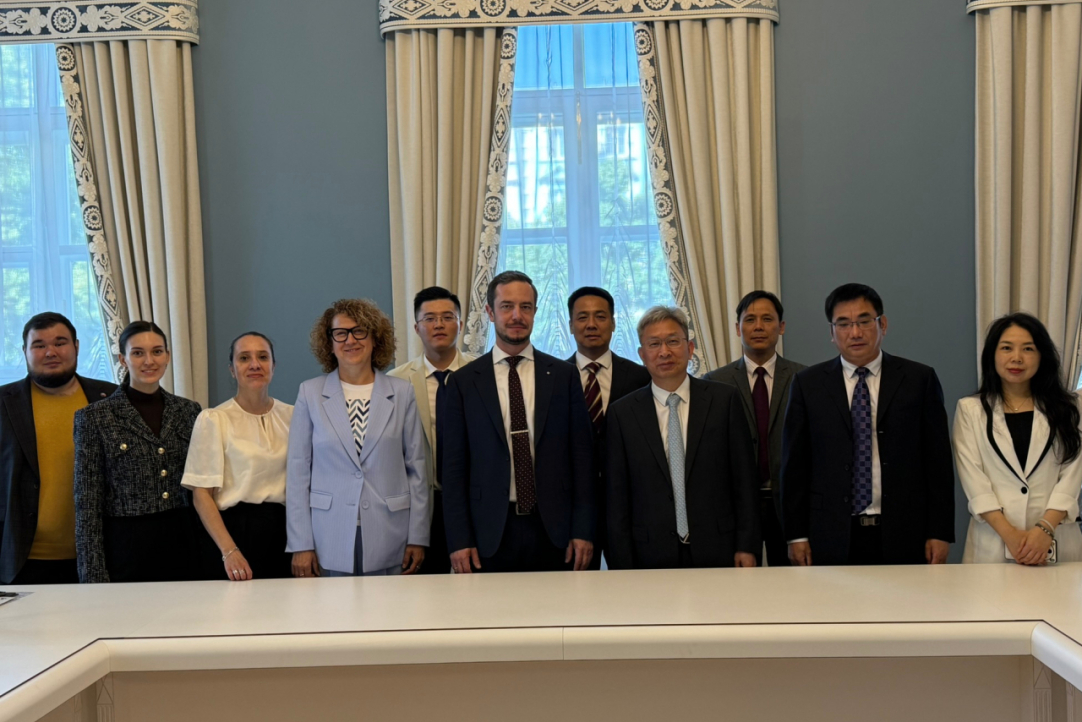HSE and Communication University of Zhejiang Strengthen Partnership in Creative Education

On July 7, 2025, HSE University hosted a delegation from China at the historic Durasov House. The delegation, led by Wei Guotan, Chair of the University Council of Communication University of Zhejiang (CUZ), was welcomed by HSE Vice Rector Dmitry Zemtsov, Deputy Dean of the Faculty of Creative Industries Tatiana Rivchun, and representatives of the HSE Institute for Creative Industries Development and the HSE Art and Design School—the initiators of the partnership with their Chinese colleagues.
The visit focused on the further development of collaboration between the two universities. They already have experience of cooperation through academic and practical seminars on building global careers in the creative industries, as well as expert involvement in the HSE Creative Open competitions.
At the opening of the meeting, Dmitry Zemtsov highlighted the importance of developing international partnerships for HSE University, which ranks among the world’s top 100 universities in several subject areas according to the QS World University Rankings by Subject. The vice rector emphasised the value of cooperation in implementing initiatives to support young professionals, including international competitions. He also noted the significant contribution that CUZ—with its extensive expertise in contemporary media, communications, and design—could make to the work of the HSE Art and Design School and the Institute for Creative Industries Development.
‘HSE University offers double degree undergraduate and master’s programmes in partnership with world-class universities. We look forward to building on our existing ties through new joint projects, competitions, and postgraduate educational programmes,’ said Dmitry Zemtsov.
In his response, Wei Guotan stressed the importance of collaboration with HSE University for CUZ, one of China’s leading universities in the field of communications. Founded in 1978 through a joint initiative by the Zhejiang provincial government and the National Radio and Television Administration, CUZ has two campuses in Hangzhou and Tongxiang. The university has partnerships with over 150 international institutions, and many of its students continue their studies abroad.
‘We are interested in academic exchange for both students and faculty, as well as in developing joint educational programmes, and we would be glad to welcome representatives of HSE University to our institution,’ Mr Wei said in his speech.
Tatiana Rivchun, Deputy Dean of the Faculty of Creative Industries and Director of the Institute for Creative Industries Development, confirmed a shared readiness to cooperate across a wide range of fields within the creative industries. These are well represented at both CUZ and HSE University, not only in design and creative industries management, but also in areas especially relevant to the Chinese side—journalism, television and radio broadcasting, cinema, music, and more.
‘A key feature of contemporary education in the creative industries is its project-oriented nature,’ Tatiana Rivchun emphasised. ‘At HSE, this approach is supported by our digital platform, which our Chinese colleagues have already encountered through their participation in the HSE Creative Open competition jury.’ The platform—hse.space—offers digital portfolios and related services that have extended beyond the faculty, the university, and even the country.
‘Our Creative City platform, which showcases projects tied to specific locations—cities and places on the map—helps our institute and school to compile a database of best practices aimed at enhancing urban appeal and engaging with local heritage. We are pleased that it already features projects from a variety of countries, and we look forward to increasing the number of Chinese and joint projects represented,’ Tatiana Rivchun added.
The parties exchanged gifts. HSE University presented images and an original print—a stylised view of Moscow—from the HSE Cities Collection illustration series by Alexandra Yeremina, student of the Art and Design School. The collection features all of HSE’s campuses. In return, Wei Guotan presented an original print in the style of traditional Chinese woodcut.
First, the Chinese delegation had a guided tour of Durasov House, where the guests learned about the historical, architectural, and cultural significance of the heritage site. They then explored HSE’s educational environment further at the Art and Design School and the Institute for Creative Industries Development on 12 Malaya Pionerskaya Street. There, the delegation visited lecture rooms and computer labs, explored studios, the Design Lab, shop, and gallery—all spaces that illustrate the transition from education to professional, commercial, and creative application in modern creative education. At the close of the visit, the Chinese colleagues reiterated their interest in continuing joint work through the portfolio platform and competition framework, and in discussing shared educational programmes and academic exchanges.

